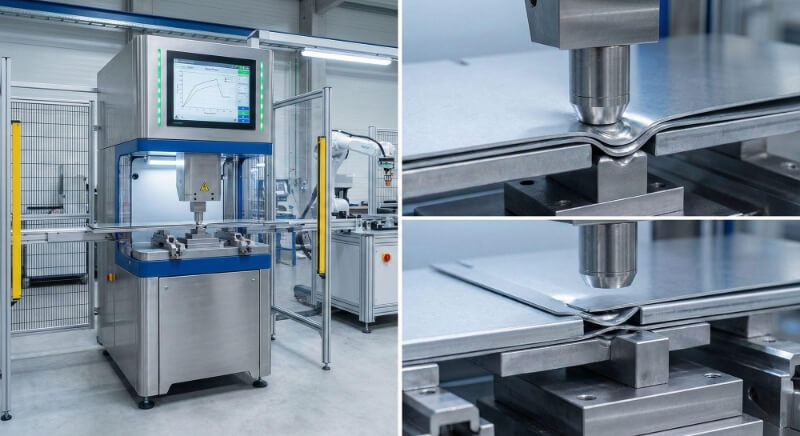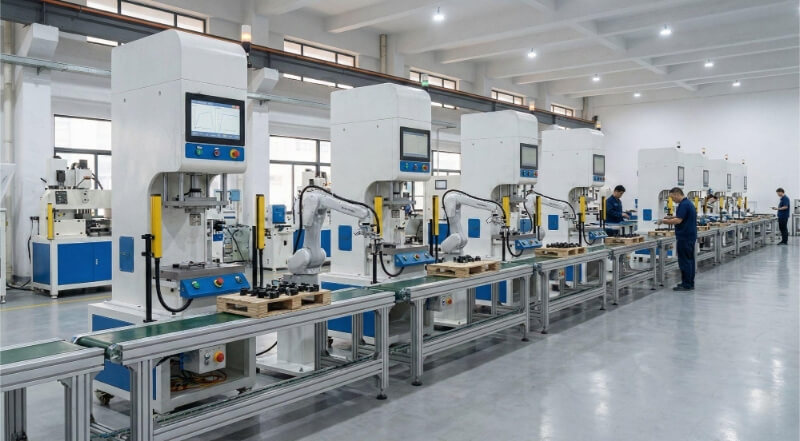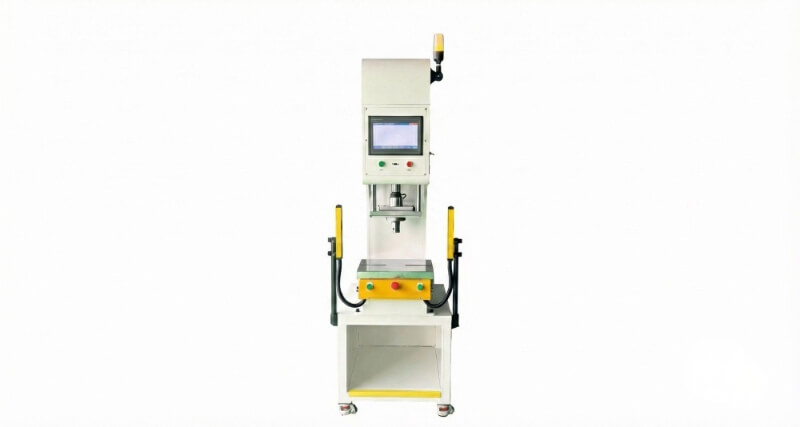Todos os fabricantes enfrentam três desafios críticos: obter cortes precisos, manter uma qualidade consistente e cumprir prazos de produção apertados. O corte manual de metal tem muitas vezes de recuperar o atraso, o que leva a desperdício de material, erros dispendiosos e atrasos nos projectos. O corte de metal CNC revolucionou o fabrico ao resolver exatamente estes problemas.
Gostaria de explorar a forma como esta tecnologia de ponta pode melhorar as suas capacidades de fabrico? Vamos examinar os principais processos, aplicações e vantagens que fazem do corte de metal CNC uma parte indispensável da produção moderna.
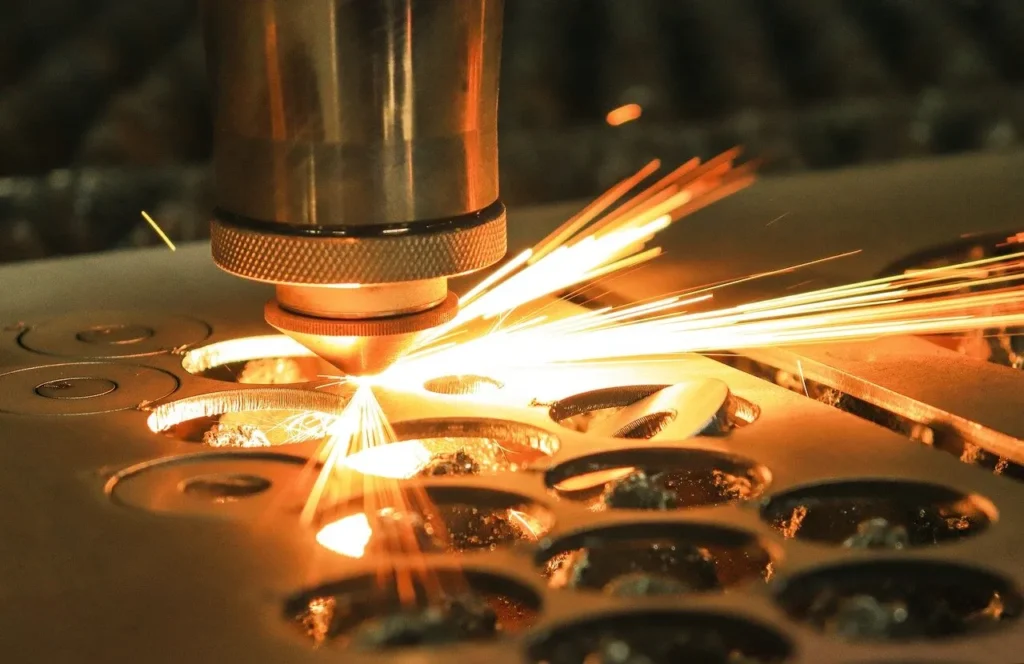
As bases do corte de metal CNC
O Controlo Numérico Computadorizado revolucionou a metalurgia ao introduzir a precisão automatizada no fabrico. Esta tecnologia faz a ponte entre o design e a produção, transformando projectos digitais em componentes físicos.
O que é o corte de metal CNC?
O corte de metal CNC transforma o stock de metal bruto em peças acabadas através da remoção controlada de material. O processo baseia-se em ferramentas de corte especializadas que seguem trajectórias precisas, guiadas por computador. Este método cria tudo, desde simples suportes a complexos componentes aeroespaciais.
Uma operação típica de corte de metal CNC começa com um desenho CAD. O sistema converte este desenho em instruções da máquina, que depois orientam as ferramentas de corte para remover o material de forma sistemática. O resultado produz peças com uma precisão excecional, exigindo frequentemente um pós-processamento mínimo.
Como funcionam as máquinas CNC
Pense nas máquinas CNC como sistemas altamente coordenados que funcionam em perfeita harmonia. O cérebro do computador interpreta as instruções programadas. Em seguida, dirige os componentes mecânicos com uma precisão de microssegundos.
A máquina monitoriza inúmeras variáveis durante o funcionamento. A velocidade de corte, a posição da ferramenta e a taxa de alimentação do material alteram-se automaticamente conforme necessário. Sensores avançados evitam falhas e mantêm condições de corte óptimas.
Tipos de máquinas CNC utilizadas no corte de metais
Cada tipo de máquina CNC serve necessidades de fabrico específicas. As fresadoras são excelentes na criação de formas e padrões 3D complexos. Os tornos produzem peças cilíndricas com uma precisão incrível. As máquinas multieixos combinam estas capacidades para uma versatilidade máxima.
O fabrico moderno utiliza frequentemente máquinas CNC especializadas. As fresadoras de cinco eixos criam componentes aeroespaciais complexos. Os tornos do tipo suíço produzem dispositivos médicos minúsculos. As máquinas de pórtico de grandes dimensões lidam com peças industriais maciças. Esta variedade garante que os fabricantes podem escolher a ferramenta correta para cada trabalho.
Principais processos de corte de metal CNC
Cada método de corte CNC serve necessidades de fabrico específicas. Estes processos diferem em termos de velocidade, precisão e compatibilidade de materiais. A escolha depende dos requisitos do seu projeto, do tipo de material e do volume de produção.
Fresagem: Definição e visão geral do processo
Fresagem utiliza ferramentas rotativas para remover metal de peças de trabalho. A ferramenta de corte move-se através da superfície do material em várias direcções, criando superfícies planas, formas 3D complexas e caraterísticas detalhadas.
Torneamento: Como funciona no corte de metais
Girando gira a peça de trabalho enquanto uma ferramenta de corte estacionária a molda. O processo é excelente na criação de peças cilíndricas com elevada precisão. As aplicações típicas incluem veios, parafusos e outros componentes redondos.
Perfuração: O papel da perfuração no corte CNC
Perfuração CNC cria furos precisos em peças de metal. O controlo por computador garante um diâmetro e uma profundidade de furo consistentes. As máquinas modernas podem perfurar em ângulos e criar automaticamente padrões de furos complexos.
Usinagem por Descarga Elétrica (EDM)
O EDM corta o metal utilizando faíscas eléctricas num fluido dielétrico. Este processo processa aço endurecido e cortes internos complexos. Consegue tolerâncias muito apertadas sem força mecânica.
Corte a laser: Uma visão geral
Corte a laser derrete ou vaporiza o metal com feixes de luz focados. Este método permite obter arestas limpas e pormenores intrincados. Funciona excecionalmente bem para chapas metálicas e materiais finos.
Corte por jato de água: Vantagens e aplicações
Jactos de água misturam água com partículas abrasivas para cortar metal. Este processo de corte a frio evita a distorção pelo calor. Corta materiais espessos, mantendo as propriedades do material.
Corte a plasma: Um método popular para o fabrico de metais
Corte a plasma utiliza gás ionizado para cortar metais condutores. O processo oferece velocidades de corte rápidas para materiais espessos. Equilibra o custo e a qualidade para muitas aplicações industriais.
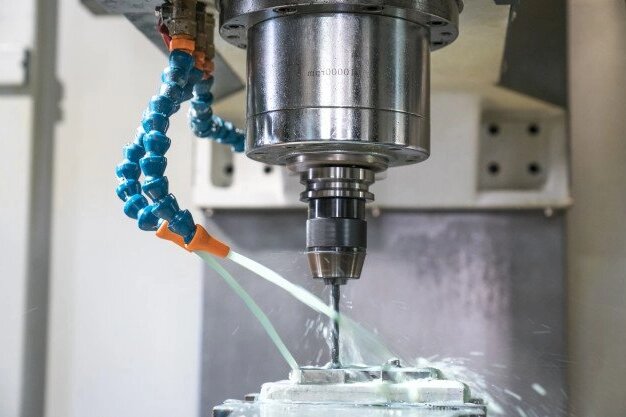
Que materiais podem ser cortados com máquinas CNC?
As capacidades de corte de metal variam consoante o tipo e a espessura do material. Cada método CNC corresponde às propriedades específicas do metal e aos requisitos do trabalho. O método de corte adequado equilibra a precisão, a velocidade e a relação custo-eficácia.
Aqui está uma tabela de referência rápida para materiais padrão e suas capacidades de corte:
| Tipo de material | Corte a laser | Puncionamento CNC | Fresagem CNC | Corte Plasma |
|---|---|---|---|---|
| Alumínio | Até 10 mm | Até 6 mm | Sem limite de espessura* | Até 50 mm (início do bordo) |
| Aço suave | Até 32 mm (1,25") | 0,5-6 mm | Sem limite de espessura* | Até 38 mm |
| Aço inoxidável | Até 12 mm | 0,5-6 mm | Sem limite de espessura* | Até 25 mm |
| Latão | Até 6 mm | Até 4 mm | Sem limite de espessura* | Até 20 mm |
| Cobre | Até 4 mm | Até 3 mm | Sem limite de espessura* | Até 20 mm |
Benefícios do corte de metal CNC
O fabrico de metais exige precisão e eficiência no mercado competitivo atual. A tecnologia CNC satisfaz estes requisitos, combinando a automatização avançada com capacidades de fabrico robustas. Esta secção explora as principais vantagens que fazem do corte de metal CNC uma pedra angular da produção moderna.
Maior precisão e consistência
O controlo digital garante que cada corte corresponde perfeitamente às especificações. As máquinas mantêm uma precisão de microns ao longo de toda a produção. Esta precisão permite obter os seguintes resultados:
- Resultados repetíveis em milhares de peças
- Variação mínima entre lotes
- Redução dos problemas de controlo de qualidade
- Ajuste e montagem perfeitos nos produtos finais
Eficiência de custos e redução de resíduos
A programação inovadora e a automatização reduzem significativamente os custos operacionais. A precisão das máquinas CNC minimiza o desperdício de material. Os resultados mostram-no:
- Custos de mão de obra mais baixos por peça
- Redução das taxas de desperdício de material
- Menos peças rejeitadas
- Utilização optimizada do material
- Diminuição dos requisitos de retrabalho
Produção a alta velocidade e tempos de execução
As máquinas CNC trabalham mais rapidamente do que os métodos manuais, mantendo a qualidade. Funcionam continuamente com um tempo de inatividade mínimo. As vantagens incluem:
- Capacidade de produção 24/7
- Mudanças rápidas de configuração
- Desenvolvimento rápido de protótipos
- Cumprimento mais rápido das encomendas
- Calendários de produção simplificados
Flexibilidade na conceção e na criação de protótipos
Os controlos digitais permitem modificações rápidas na conceção e produção personalizada. Os fabricantes podem adaptar-se rapidamente às exigências do mercado. Isto cria:
- Actualizações de design fáceis
- iterações rápidas de protótipos
- Produção de peças personalizadas
- Capacidade de geometria complexa
- Múltiplas opções de materiais
Aplicações do corte de metal CNC
O corte de metal CNC abrange várias indústrias, criando peças que vão desde componentes aeroespaciais críticos a peças de arte complexas. A tecnologia adapta-se a diversas necessidades de produção, desde protótipos únicos até ao fabrico de grandes volumes.
Indústrias Aeroespacial e Automotiva
Estes sectores exigem a maior precisão e fiabilidade nas peças metálicas. O corte CNC cumpre as rigorosas normas da indústria através de:
- Componentes do motor com tolerâncias apertadas
- Peças estruturais para aeronaves
- Componentes do sistema de freio
- Peças de transmissão
- Elementos do chassis personalizados
Fabrico de dispositivos médicos
O fabrico de produtos médicos exige uma limpeza e uma precisão excepcionais. As máquinas CNC produzem:
- Instrumentos cirúrgicos
- Componentes de implantes
- Peças de equipamento de diagnóstico
- Caixas para dispositivos médicos
- Componentes protéticos personalizados
Corte de metal CNC em eletrónica
A eletrónica moderna depende de componentes metálicos precisos. As aplicações mais comuns incluem:
- Dissipadores de calor
- Chassis e caixas
- Material de montagem da placa de circuitos
- Caixas de conectores
- Protecções EMI
Fabrico personalizado de peças industriais
O equipamento industrial necessita de componentes duráveis e precisos. O corte CNC cria:
- Peças de reposição
- Componentes de máquinas personalizados
- Equipamento da linha de produção
- Ferramentas de manuseamento de materiais
- Ferramentas especializadas
Corte CNC em arte e escultura
Os artistas utilizam a tecnologia CNC para ultrapassar os limites da criatividade. As aplicações incluem:
- Arte mural em metal
- Esculturas em grande escala
- Elementos arquitetônicos
- Painéis decorativos
- Sinalética personalizada
Máquinas agrícolas e pecuárias
Os quadros das máquinas para animais, como os seguintes, requerem um corte preciso:
- Estábulos para cavalos
- Equipamento para estábulos de cavalos
- Abrigo para cavalos
Conclusão
O corte de metal CNC revoluciona o fabrico moderno com precisão digital. A tecnologia oferece uma precisão superior, velocidade e versatilidade em vários materiais. O sucesso no corte CNC advém da combinação do processo adequado com o material específico e as necessidades do projeto.
FAQs
Quanto custa o metal CNC?
Os custos do corte de metal CNC variam com base em vários factores-chave. O tipo e a espessura do material afectam o tempo de corte e o desgaste da ferramenta. A complexidade da peça influencia os requisitos de programação e configuração. O tempo de máquina varia normalmente entre $75 e $250 por hora.
Qual é a precisão do corte de metal CNC?
As máquinas CNC alcançam uma precisão notável nas operações de corte de metal. As tolerâncias padrão atingem ±0,001 polegadas (0,025mm) para a maioria das aplicações. As máquinas de alta precisão podem atingir tolerâncias ainda mais apertadas quando necessário.
Qual a espessura do metal que uma máquina CNC pode cortar?
As capacidades de espessura do corte de metal dependem do processo e do material. Os sistemas de laser lidam com aço até 1,25 polegadas de espessura, os cortadores de plasma lidam com alumínio até 3 polegadas e os jactos de água cortam várias polegadas de metal.
Como é que o corte CNC melhora a eficiência no fabrico?
O corte CNC simplifica o fabrico através da automatização e da precisão. As máquinas trabalham continuamente sem fadiga. O armazenamento de programas permite mudanças rápidas de trabalho. As capacidades multieixos completam peças complexas numa única configuração.
Os fluxos de trabalho digitais reduzem os erros e o desperdício. A gestão automatizada de ferramentas maximiza o tempo de atividade. A inspeção integrada garante uma qualidade consistente. Estas caraterísticas combinam-se para aumentar a produtividade, mantendo elevados padrões.
Olá, chamo-me Kevin Lee

Nos últimos 10 anos, tenho estado imerso em várias formas de fabrico de chapas metálicas, partilhando aqui ideias interessantes a partir das minhas experiências em diversas oficinas.
Entrar em contacto

Kevin Lee
Tenho mais de dez anos de experiência profissional no fabrico de chapas metálicas, especializando-me em corte a laser, dobragem, soldadura e técnicas de tratamento de superfícies. Como Diretor Técnico da Shengen, estou empenhado em resolver desafios complexos de fabrico e em promover a inovação e a qualidade em cada projeto.

